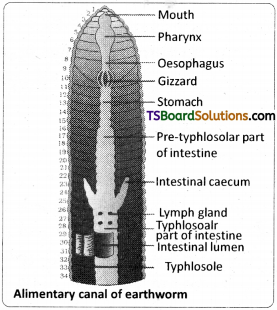Telangana TSBIE TS Inter 1st Year Zoology Study Material 3rd Lesson Animal Diversity-I: Invertebrate Phyla Textbook Questions and Answers.
TS Inter 1st Year Zoology Study Material 3rd Lesson Animal Diversity-I: Invertebrate Phyla
Very Short Answer Type Questions
Question 1.
What physical feature pertaining to the organism and its medium do you notice in a sponge body from which sponges can be/were identified as animals and not plants? What do you call the region in the sponge body in which you noticed that feature?
Answer:
Sponge body possesses two types of pores. Small pores are called ostia which are numerous and large one or two pores are called oscula. The osculum propels out water coming from body cavity called spongocoel. The presence of osculum confirm the sponge is an animal. It is situated at anterior free end.
Question 2.
What are the different structures that makeup the internal skeleton of a sponge? What are the chemicals involved in the formation of these structures?
Answer:
The body of sponge is supported by skeleton made up of calcareous or siliceous spicules or spongin fibres or both. Calcareous spicules are made up of CaCO3 Siliceous spicules are made up of glass (silicon dioxide). Spongin is fibre material.
Question 3.
What are the functions of canal system of sponges? [March 2018 – A.P.; March 2013]
Answer:
Sponges have a water transport system or canal system that constantly conducts water. It helps in gathering food (filter feeders), exchange of gases (respiration) and removal of wastes (excretion).
Question 4.
What are the two chief morphological ‘body forms’ of cnidarians? What are their chief functions? [March 2020]
Answer:
The two chief morphological body forms of cnidarians are
1. Polyp 2. Medusa.
Polyp is sessile cylindrical form and produce medusae asexually by budding. Medusa is umbrella-shaped and free swimming form and sexually produce polypoid forms.
Question 5.
What is metagenesis? Animals belonging to which phylum exhibit metagenesis?
Answer:
The cnidarians which exist in both forms namely polyp and medusa exhibit alternation of generations called metagenesis. Polyps by asexually method called budding produce medusae. Medusae by sexual method called syngamy give rise to polypoid forms.
![]()
Question 6.
What is the cnidarian group with quantitatively / relatively large mesoglea? What is the significance of such a well developed mesoglea pertaining to the aquatic life of that group?
Answer:
In cnidarians, the animals of class scyphozoa contain relatively large mesoglea containing amoebocytes. The mesoglea is important in buoyancy.
Question 7.
What is the chief difference between the hydrozoans and the rest of the cnidarians regarding the germinal layer(s) in which its ‘defencive structures or cells of defence’ occur?
Answer:
The chief difference between the hydrozoans and the rest of the cnidarians regarding the germinal layer in which its defencive structures or cells of defence called cnidocytes occur is only in ectoderm. In others, cnidocytes are present both in ectoderm and endoderm.
Question 8.
What are the excretory cells of flatworms called? What is the other important function of these specialized cells?
Answer:
The excretory cells of flatworms are called Flame cells (protonephridia). They help in osmoregulation and excretion.
Question 9.
Distinguish between amphids and phasmids [March 2019]
Answer:
a) Amphids are cuticular depressions around oral region performing chemoreceptor function.
b) Phasmids are posterior glandulo – sensory structures. Both are found in Nematodes.
Question 10.
What is the essential difference between a ‘flat worm’ and a ’round worm’ with reference to the perivisceral area of their bodies?
Answer:
Flat worms are the first bilaterally symmetrical triploblastic and acodomate animals. Round worms are bilaterally symmetrical, triploblastic and pseudocoelomate animals.
Question 11.
How do you account for the origin of the perivisceral space in the body of a nematode and an annelid?
Answer:
- In nematodes during embryonic development, mesoderm occupies only a part of the blastocoel adjoining the ectoderm. The unoccupied portion of the blastocoel persists as pseudocoelom.
- In annelids the perivisceral space is a true coelom formed by splitting of mesodermal blocks between ectoderm and endoderm which is a schizocoelom.
![]()
Question 12.
What is metamerism? What is the essential difference between the mode of formation of individual morphological body units of a tapeworm and those of an earthworm?
Answer:
Metamerism is division of body into segments divided by septa and are referred to as metameres. This is unique of annelids. Segments are formed at posterior tip.
Pseudometamerism is found in tape worm. There is no actual division of segments intervally. But gives false appearance because segments called proglottids are attached to each other. They are formed at anterior end.
Question 13.
How do you distinguish a ‘hirudinean’ from the rest of the annelids, based on the morphological features pertaining to metamerism? How does the coelom of a leech differ from the coelom of an earthworm with reference to its contents?
Answer:
In Hirudineans the body is with definite number of segments. The segments are externally subdivided into annuli. Internal segmentation is absent. Coelom of leech is filled with a characteristic tissue called botryoidal tissue. This is absent in earthworm.
Question 14.
What do you call the locomotor structures of Nereis? Why is Nereis called a polychaete?
Answer:
In polychaetes parapodia are the locomotory structures. Which hear many setae. Hence the name polychaeta. Nereis is a polychaete because of parapodia with many setae are seen.
Question 15.
What is botryoidal tissue?
Answer:
Botryoidal tissue is a characteristic tissue filled in the coelom of leeches (hirudineans). This tissue is believed to be excretory in funtion.
Question 16.
What is the difference between the epidermis of a nematode and that of an annelid? How does a nematode differ from an annelid with reference to the musculature of the body wall?
Answer:
- In nematodes the unsegmented body is covered by a transparent tough and protective collagenous cuticle. In some epidermis is synctial. Only longitudinal muscles are present (circular muscles are absent).
- In annelids the segmented body possesses dermo-muscular body wall containing cuticle, epidermis, dermis, longitudinal and circular muscles.
Question 17.
What do you call the first and second pairs of cephalic appendages of a scorpion?
Answer:
The first and second pairs of cephalic appendages of a scorpion are-called chelicerae and pedipalpi respectively.
![]()
Question 18.
What is the uniqueness about the first two pairs of cephalic appendages of a crustacean compared to those of the other extant arthropods?
Answer:
In Crustacea Head and Thorax are fused to form cephalothorax. The first two pairs of cephalic appendages are antennules and antennae which is unique feature.
Question 19.
What is the sub-phylum to which ‘ticks’ and ‘mites’ belong? How do you distinguish them from the insects with reference to their walking legs?
Answer:
Ticks and mites belong to sub-phylum chelicerata. They are differed from insects in having four pairs of walking legs. Insects possess three pairs of walking legs.
Question 20.
What are the respiratory structures of Limulus and Palamnaeus respectively?
Answer:
- Respiratory structures of Limulus (King crab) → Book – gills
- Respiratory structures of palaemnaeus (scorpion) → Book-lungs.
Question 21.
What are antennae? What is the arthropod group without antennae?
Answer:
Antennae are cephalic appendages of arthropods which are sensory in function (sense of touch). They are absent in the sub-phylum chelicerata.)
Question 22.
What do you call the perivisceral cavity of an arthropod? Where from is it derived during development?
Answer:
The perivisceral cavity of arthropods is called Haemocoel (blood cavity) derived from mostly the embryonic blastocoel.
Question 23.
Which arthropod, you have studied, is called a ‘living fossil’? Name its respiratory organs. [March 2015 – A.P.]
Answer:
Limulus (King crab) belonging to class Xiphosura of sub-phylum chelicerata is called living fossil. Its respiratory organs are book gills.
Question 24.
How do you identify a Chiton from its external appearance? How many pairs of gills help in the respiration of Chiton?
Answer:
Chiton is identified by a dorsal shell consisting of 8 transverse plates. 6 – 88 pairs of gills help in respiration of Chiton.
![]()
Question 25.
What is the function of radula? Give the name of the group of molluscs which do not possess a radula. [May/June, March 2014]
Answer:
The buccal cavity of molluscs contain a file like rasping organ called radula for feeding. It is absent in the class bivalve or pelecypoda.
Question 26.
What is the other name for the gill of a mollusc? What is the function of osphradium?
Answer:
Ctenedia is the other name of gill of a mollusc. Osphradium in molluscs tests the purity of water. It is present in the bivalves and gastropods.
Question 27.
What is Aristotle’s lantern? Give one example of an animal possessing it. [May 2017 ; Mar. ’17 – A.P ; Mar. 2015 – T.S]
Answer:
In the mouth of a sea urchin a complex five jawed masticatory apparatus called Aristotle’s lantern is present. Example : Echinus (sea urchin).
Question 28.
What is the essential difference between the juveniles and adults of echinoderms, symmetry wise?
Answer:
- Adult of echinoderms exhibit pentamerous radial symmetry.
- Juveniles of echinoderms exhibit bilateral symmetry.
Question 29.
What are blood glands in Pheretima?
Blood glands in pheretima are present in the 4th, 5th, and 6th segments. They produce blood cells and haemoglobin which is dissolved in plasma. Blood cells are phagocytic in nature.
![]()
Question 30.
What are spermathecae on the body of pheretima?
Answer:
4 pairs of spermathecae are located in the segments 6th to 9th (one pair in each segment). They receive and store sperms during copulation.
Short Answer Type Questions
Question 1.
Write short notes on the salient features of the anthozoans.
Answer:

Class – Anthozoa or Actinozoa :
- They are commonly referred to as sea anemones.
- They are sedentary and only polypoid in form.
- Coelenteron is divided into several compartments by vertical septa called mesenteries.
- Mesoglea contains connective tissue.
- Cnidocytes occur both in the ectoderm and endoderm.
- Germ cells are derived from the endoderm.
Examples : Adamsia (sea anemone), Corallium rubrum (precious red stone coral), Gorgonia (sea fan), Pennatula (sea pen).
Question 2.
What is the class to which the flukes belong? Write short notes on the chief characters of that group.
Answer:
Flukes belong to class Trematoda of phylum platyhelminthes.
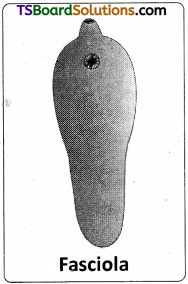
Class – Trematoda:
- They are commonly called flukes.
- They are parasitic on other animals.
- Body is covered by a thick cuticle (tegument); bears two suckers, an oral and a ventral (acetabulum).
- Mouth is anterior and the intestine is bifurcated.
- They are bisexual (monoecious).
- Life history is complex with many hosts and different types of stages (miracidium, sporocyst, redia, cercaria etc.).
Examples : Fasciola (liver fluke), Schistosoma or Bilharzia (blood fluke).
Question 3.
What are the salient features exhibited by polychaetes?
Answer:
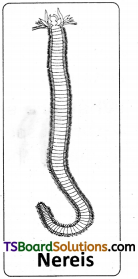
Class – Polychaeta salient features :
- Polychaeta (poly : many; chaetae : setae) includes marine annelids commonly called ‘bristle worms’.
- Some are free-moving and others burrowing or tubicolous (tube dwelling).
- Head is distinct with sense organs such as eyes, tentacles and palps.
- Parapodia which bear many setae (hence the name polychaeta) help in locomotion and respiration.
- Clitellum is absent.
- They are dioecious (unisexual); gonoducts are absent; gametes are shed into the coelom and passed out through the nephridiopores.
- Fertilization is external; development includes a trochophore larva.
Examples : Nereis (sandworm or ragworm or clam worm), Aphrodite (sea mouse), Arenicola (lugwarm).
Question 4.
How do the hirudineans differ from the polychaetes and oligochaetes?
Answer:
Class: Hirudinea.
- Hirudinea (hirudo : leech) includes leeches.
- All are ectoparasites; majority live in fresh water; some are marine and others live on moist land (terrestrial).
- They have dorso-ventrally flattened body with a ‘definite number1 of segments; the segments are externally subdivided into ‘annuli’; internal segmentation is absent.
- Suckers help in locomotion.
- Clitellum is conspicuous during the breeding season only.
- Coelom is filled with a characteristic tissue called botryoidal tissue.
- They are monoecious (hermaphroditic); males possesses a copulatory organ, the cirrus.
- Fertilization is internal and development is direct.
Examples: Hirudinaria (freshwater leech), Pontobdella (marine leech), Haemadipsa (land leech).
Question 5.
What are the chief characters of the crustaceans? [May – 2017 – A.P.; March 2015 T.S.]
Answer:
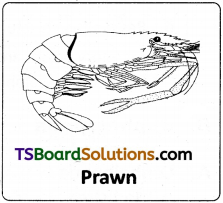
Class – Crustacea – Chief characters :
- They are aquatic.
- Head and thorax fuse forming the cephalothorax (covered by chitinous carapace). In some the exoskeleton is hardened by calcium carbonate (crabs and lobsters).
- Cephalic region bears two pairs of antennae (antennules and antennae – unique feature), one pair of mandibles and two pairs of maxillae.
- Thoracic and abdominal appendages are ‘biramous’
- Respiratory organs are gills (branchiae).
- Excretory organs are green glands or antennary glands.
- Sense organs include antennae compound eyes, statocysts, etc.
- Development is indirect and includes different larval forms.
Examples : Palaemon (freshwater prawn), Cancer (crab), Balanus (rock barnacle),
Sacculina (root-headed barnacle), Astacus (cray fish), Daphnia (water flea).
![]()
Question 6.
Mention the general characters of Arachnida. [May/June ’14]
Answer:
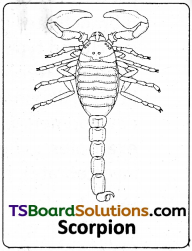
Class – Arachnida general characters :
- They are terrestrial.
- Prosoma bears a pair of chelicerae, a pair of pedipalpi and four pairs of walking legs.
- Mesosomal appendages are modified into book lungs.
- Four pairs of posterior abdominal appendages are modified into spinnerets in spiders.
- Respiratory organs are book – lungs (scorpions and some spiders), tracheae (some spiders) or both (some spiders).
- Respiratory pigments is ‘copper1 containing haemocyanin.
- Excretory organs are malpighian tubules and coxal glands.
- Development is direct; scorpions are viviparous.
Example : Palamnaeus (scorpion), Aranea (spider), Sarcoptes (itch mite).
Question 7.
Compare briefly a centipede and a millipede.
Answer:
| Centipede (chilopod) | Millipede (Diplopod) |
| 1) Commonly called hundred leggers. | 1) Commonly called thousand leggers. |
| 2) Terrestrial, air breathing carnivorous animals. | 2) Terrestrial air breathing animals feeding on decaying plant material. |
| 3) Body consists of head and trunk | 3) Body consists of head and trunk. |
| 4) Each segment of trunk bears a pair of clawed appendages. | 4) Head bears paired antennae, mandibles and maxillae, (Maxillae modified into gnathochilarium) |
| 5) First pair of trunk appendages bear poison claws. | 5) Each trunk segment bear two pairs of legs. |
| 6) Respiratory structures are tracheae | 6) Respiratory structures are tracheae. |
| 7) Excretory organs are Malpighian tubules. Ex : Scolopendra, Scutigera |
7) Excretory organs are Malpighian tubules Ex: Spirostreptus, Julus. |
![]()
Question 8.
Cephalopods show several unique or advanced features when compared to the other molluscs. Discuss briefly.
Answer:
Cephalopoda or Siphonopoda is an advanced group of Mollusca. This class includes cuttle fishes, squids, octopuses, nautili etc. Head is distinct with conspicuous eyes similar to those of vertebrates, a pair of horny beak like jaws and a radula occur in the buccal cavity. Shell may be external and multi – chambered (Nautilus) or internal (Sepia, Loligo) or absent (Octopus). The shell of Sepia is commonly called ‘cuttle bone’ and that of Loligo is commonly called ‘pen’. Foot is modified into eight (octopus) to ten arms (Sepia, Loligo) provided with suckers present around the mouth and a part of the foot is modified into a ‘siphon’ (useful in swift darting movements).
Some possess ink gland and eject a cloud of ink to escape from the predators (defensive adaptation). Ctenidia, atria and nephridia are two in dibranchiates (Sepia) and four in tetrabranchiates (Nautilus). Circulatory system is a closed type (unique feature of cephalopoda); heart’has two to four atria and a ventricle. Nervous system is well developed with a well developed brain enclosed in a cartilaginous cranium (braincase). They are dioecious (sexes are separate); development is direct.
examples : Sepia (cuttle fish), Architeuthis (giant squid – the largest living invertebrate), Nautilus, Octopus (devil fish).
Question 9.
Which class of Mollusca represents the primitive molluscs? What are their chief features?
Answer:
Class Aplacophora represents the primitive molluscs. They are primitive ‘worm like’ marine molluscs without mantle, shell, foot and nephridia. Head is poorly developed; a radula is present. Cuticle contains calcareous spicules. In some there is a mid-ventral groove which is homologous to the foot of the other molluscs. Examples: Neomenia, Chaetoderma.
Question 10.
What are the salient features of the echinoids? [March 2019, ’17 – A.P.]
Answer:
- The class Echinoidea includes sea urchins, heart urchins, sand dollars, sea biscuits, etc.
- The body is ovoid or discoid and covered with morable spines.
- Arms are absent; tube feet bear suckers.
- Calcarious ossicles of the body unite to form a rigid test or corona or case.
- Madreporite and anus are aboral in position.
- Ambulacral grooves are closed.
- Pedicellariae are three jawed.
- In the mouth of sea urchin a complex five jawed masticatory apparatus called Aristotle’s lantern is present (absent in the heart urchins).
- Development includes echinopluteus larava.
Examples: Echinus (sea urchin), Echinocardium (heart urchin) Echinodiscus (sand dollar).
Question 11.
Mention the salient features of Holothuroidea. [March 2015 – A.P.]
Answer:
Holothuroidea-salient features.
- This class includes sea cucumbers.
- Body is elongated in the oro-aboral axis.
- Skin is leathery (coriaceous) and dermis contains loose spicules.
- Arms, spines and pedicellariae are absent. .
- Mouth is surrounded by retractile tentacles (modified tube feet useful for feeding).
- Ambulacral grooves are ‘closed1; tube feet bear suckers.
- Madreporite is internal (occurs in coelom).
- Respiratory organs are a pair of cloacal ‘respiratory trees’.
- Development is indirect and includes auricularia larva.
Examples : Holothuria, Synapta, Thyone.
Question 12.
What is the function of Nephridia?
Answer:
The excretory organs occur as segmentally arranged called tubules, called nephridia. Earthworms are mostly ureotelic animals. The chief nitrogenous excretory waste is urea enteronephric nephridia have a role in asmoregulation/conservation/ homeostasis of water. Exonephric nephridia collect nitrogenous wastes and send them out through nephridiopores. They are ciliated coelomic ducts.
Question 13.
How many types of nephridia occur in pheretima and how do you distinguish them?
Answer:
There are 3 types of nephridia. 1) Septal nephridia present on both sides of the inter segmental septa of segments 15th/16th to the last. They open into the intestine. 2) Integumentary nephridia attached to inner body wall from 3rd segment to last. Open out by nephridiopores. 3) Pharyngeal nephridia present as three paired tufts in the segments 4th, 5th and 6th. They open into buccal cavity and pharynx. Septal nephridia with nephrostomes but without nephridiopore. Pharyngeal and integumentary without nephrostomes. Pharyngeal nephridia without Nephrostome and nephridiopore.
![]()
Question 14.
Give an account of the hearts on the circulatory system of pheretima.
Answer:
In pheretima there are 4 pairs of hearts which connect the dorsal and ventral blood vessels in 7, 9, 12,13 segments. They are muscular and valvular. They allow blood from dorsal blood vessel to ventral blood vessel only. The 12th, 13th segment lateral hearts are also called as lateral oesophageal hearts as they receive blood from supra oesophageal blood vessel and give to ventral blood vessel.
Essay Answer Type Questions
Question 1.
Draw a neat labelled diagram of the reproductive organs of pheretima.
Answer:
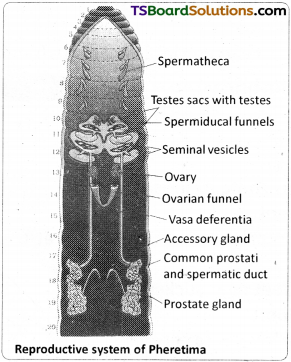
Question 2.
Describe the digestive system and process of digestion in pheretima.
Answer:
Digestive system :
The alimentary canal is a straight tube and runs from the first to the last segment of the body (Fig). The mouth opens into the buccal cavity (1-3 segments) which leads into the muscular pharynx (4th segment). A small narrow tube. Oesophagus (5-7 segments), continues into a muscular gizzard (8th segment). It helps in grinding the small particles of food the decaying leaves (grinding mill). The stomach extends fpm the segments 9 glands, present in the stomach, neutralise the humic acid present in the humus of the soil. The intestine starts from the 15th segment and continues till the last segment.
A pair of short and conical intestinal caecae project from the intestine in the 26th segment. An internal median fold of the dorsal wall of the intestine called typhlosole, helping in increasing the area of absorption, is poorly developed in Pheretima (between the 26th and the rectum, which occupies the last 23 to 28 segments). The alimentary canal opens to the exterior by a small rounded aperture called anus. The ingested soil rich in organic mater passes through the digestive tract where digestive enzymes breakdown complex food into smaller absorbable units. These simpler molecules are absorbed through intestinal membranes and are utilised for various metabolic activities.
